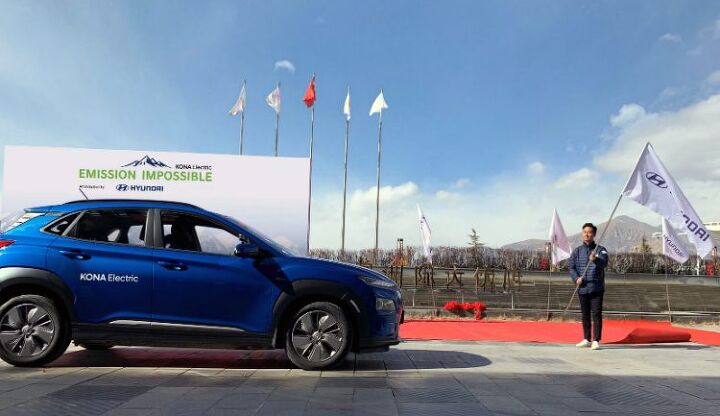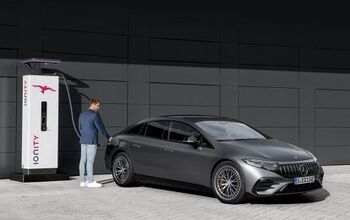Hyundai Hopes to Boost Kona Electric Interest With Mountainous Publicity Stunt

Hyundai Motor Group India hopes to grow interest in the Kona Electric by having the subcompact crossover become the first EV to drive to Mount Everest’s base camp. While demand for the model has so far been relatively low, with deliveries averaging roughly 100 units per month in the U.S., it’s performed rather well globally (for an EV). Hyundai has one of the best ratios of plug-in sales in the industry — with about 5 percent of global sales going toward something rechargeable.
The figures vary month to month, but Hyundai has been able to consistently rely on at least 4,000 EV sales per month through 2019. In October, Hyundai said it shipped over 8,000 plug-in models, with continued growth anticipated through the end of this year.
Unfortunately, Indian auto sales aren’t particularly healthy. Volume is down over 30 percent vs last year and Hyundai promised $250 million to the nation to further the sales of electric and hybrid vehicles. EV sales are particularly bad, with estimates of all-electric passenger vehicles being no higher than 10,000 units (total) over the last five years. The brand likely figured a regionally focused publicity stunt might help boost interest in Asia while giving international markets a similar bump. After all, everyone in the world has heard of Everest and the dangerous ascent to its peak.
The Kona probably won’t have to contend with frozen corpses and treacherous crevasses, however. China actually built a road leading up to the mountain’s North Base Camp (17,000 ft up!) and that appears to be the path Hyundai has chosen to take. The drive began at Tibet’s capital of Lhasa on Saturday, led by mountaineer Ajeet Bajaj (who probably won’t have to do any climbing).
It’s not clear which model Hyundai has taken to the mountain. Indian-spec Kona Electrics use a 39.2-kWh battery pack that’s substantially smaller than the unit we get here in North America. Still, there would be questions about range either way. While mostly paved, the 450-mile road cuts through some of the most desolate terrain on the planet, with few stops being capable of recharging EVs. The Kona will have depleted its battery several times over on the frigid journey, likely requiring some kind of support team to come with.
At its core, this is a publicity stunt designed to make the Kona Electric more appealing — both in India and abroad. It also allows Hyundai to showcase the advantages of electrification at high elevations where internal combustion vehicles begin wheezing for air. But it’s not the same as the model driving up the mountain, which wouldn’t have been possible anyway.
This author doesn’t care. Even if Hyundai takes a few demerits for making this endeavor — which it has charmingly entitled “Emission Impossible” — seem more daunting than it truly is, it’s still getting eyes on one of the most enjoyable mainstream EVs currently available. This is one of the only electrics I would actually miss if it ended up suddenly being discontinued, as it makes for a enjoyable urban runabout — even if it is too expensive at $36,950 (to start).
More importantly, these are the kinds of stunts people who actually like cars can appreciate and argue about. It throws down the gauntlet, hopefully encouraging other manufacturers to attempt something similarly bold … or bolder. Remember how much publicity Ford got for pulling a train with the F-150’s electric prototype? That video received over 2 million views on Ford’s YouTube channel and was shared countless times. We don’t expect Hyundai to manage the same with its road trip to Everest, but it’s on the right track.
[Images: Hyundai Motor Group]

A staunch consumer advocate tracking industry trends and regulation. Before joining TTAC, Matt spent a decade working for marketing and research firms based in NYC. Clients included several of the world’s largest automakers, global tire brands, and aftermarket part suppliers. Dissatisfied with the corporate world and resentful of having to wear suits everyday, he pivoted to writing about cars. Since then, that man has become an ardent supporter of the right-to-repair movement, been interviewed on the auto industry by national radio broadcasts, driven more rental cars than anyone ever should, participated in amateur rallying events, and received the requisite minimum training as sanctioned by the SCCA. Handy with a wrench, Matt grew up surrounded by Detroit auto workers and managed to get a pizza delivery job before he was legally eligible. He later found himself driving box trucks through Manhattan, guaranteeing future sympathy for actual truckers. He continues to conduct research pertaining to the automotive sector as an independent contractor and has since moved back to his native Michigan, closer to where the cars are born. A contrarian, Matt claims to prefer understeer — stating that front and all-wheel drive vehicles cater best to his driving style.
More by Matt Posky
Latest Car Reviews
Read moreLatest Product Reviews
Read moreRecent Comments
- Jkross22 When I think about products that I buy that are of the highest quality or are of great value, I have no idea if they are made as a whole or in parts by unionized employees. As a customer, that's really all I care about. When I think about services I receive from unionized and non-unionized employees, it varies from C- to F levels of service. Will unionizing make the cars better or worse?
- Namesakeone I think it's the age old conundrum: Every company (or industry) wants every other one to pay its workers well; well-paid workers make great customers. But nobody wants to pay their own workers well; that would eat into profits. So instead of what Henry Ford (the first) did over a century ago, we will have a lot of companies copying Nike in the 1980s: third-world employees (with a few highly-paid celebrity athlete endorsers) selling overpriced products to upper-middle-class Americans (with a few urban street youths willing to literally kill for that product), until there are no more upper-middle-class Americans left.
- ToolGuy I was challenged by Tim's incisive opinion, but thankfully Jeff's multiple vanilla truisms have set me straight. Or something. 😉
- ChristianWimmer The body kit modifications ruined it for me.
- ToolGuy "I have my stance -- I won't prejudice the commentariat by sharing it."• Like Tim, I have my opinion and it is perfect and above reproach (as long as I keep it to myself). I would hate to share it with the world and risk having someone critique it. LOL.




































Comments
Join the conversation
Forget base camp. My F-150 made the Summit (Northeast Ridge Route) on summer tires and achieved 26.2mpg on the way up.
OMG car company makes outrageous car commercial. News @ 11. "You may *murmur* all you like"